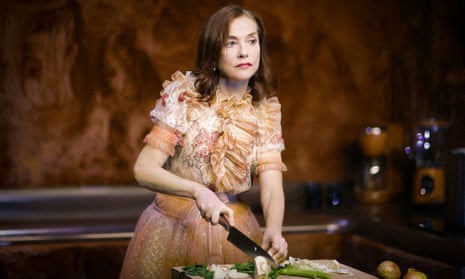Is this a latecomer weaving through the front row of the stalls? No, it’s warehouse poet Tom Wingfield, narrator of Tennessee Williams’s first hit and most autobiographical play. Nahuel Pérez Biscayart – with brush-up hair, scruffy moustache, wry smile and sunken eyes – doesn’t half look like the playwright as he performs an illusion with a scarf and rope, assisted by the audience.
For their own latest magic trick, director Ivo van Hove and designer Jan Versweyveld shrewdly plunge Williams’s 1944 memory play – set a decade earlier, in a St Louis tenement – into a subterranean domain. The family’s Victrola, typewriter and kitchen appliances are present but the floor is earthen, the burrowed walls covered with sketches of the long-gone Mr Wingfield that resemble cave paintings.
As Amanda, the skittish matriarch whom Tom berates for her “hawklike attention”, Isabelle Huppert suggests a woman both striving to rule this underground roost and protect her children. She spoon-feeds them from a bowl and fusses across the stage with the lightness of a bird; her daughter Laura (Justine Bachelet) crawls on all fours and sleeps not on the fold-out sofa imagined by Williams but hidden beneath a brown blanket in a corner nest.

Rarely has this fragile family resembled so closely the collection of glass animals treasured by Laura, whose dress (designed by An D’Huys) similarly catches the light. Their home is as much a refuge from the outside world as a place of confinement. The walls, coloured to match Huppert’s hair, emphasise her paleness. Amanda is living out her claim, on learning Laura has been skipping college classes, that she felt like hiding in a hole in the ground.
Huppert races breathlessly through Amanda’s lines, wired on the promise of gentleman caller Jim (Cyril Gueï). She adds notes of gibberish, with loosey-goosey gestures matching the frilly frivolity of her dress. All of this accentuates the silence that hits like heartburn as she learns about Jim’s betrothed, Betty, and her guttural cries of despair at the play’s end which bring an overdue flood of pity.
Biscayart’s Tom is not a bookish daydreamer but snake-hipped and louche, drunkenly dancing to an R&B slow jam with Laura and bringing home the bliss of nocturnal wanderings halfheartedly disguised as midnight movie trips. Van Hove also underlines his attraction to Jim when Tom writhes in delight at his workmate’s “Shakespeare” nickname for him.

As Amanda flirts with Jim, who moves on to kiss Laura simply because he knows he can, there is an echo of the household seduced by a stranger in Pasolini’s Theorem – previously adapted by Van Hove – though Jim is not manifestly manipulative and his catlike toying with Laura could be more explicit. Gueï swells in pride, recalling his high-school power over women, just as Huppert writhes on the kitchen sink with memories of jonquils and gentleman callers. Bachelet’s Laura, never wholly meek, shares a playful relationship with Tom and imitates a penguin’s waddle as she boasts – more than confesses – to Amanda of trips to the zoo while skipping classes.
Van Hove’s interval-free, French-language production was created for the Odéon in Paris and delayed because of the pandemic. It is characteristically punctuated with bursts of eclectic music with varying impact, including Debussy (perhaps inspired by that “silver slipper of a moon”) sounding unusually alarming.
If the portraits of the father are a bit distracting, they stress how memories are subjective and how the Wingfields are haunted by the past and left behind while Jim strides into a tech-powered future. Van Hove recognises the individual searches for strength within this fragile family but shows, too, how memories – like this underground lair – can confine as well as comfort.
La Ménagerie de Verre is at the Internationaal Theater Amsterdam until 28 November and livestreamed with English subtitles on 27 November

Comments (…)
Sign in or create your Guardian account to join the discussion